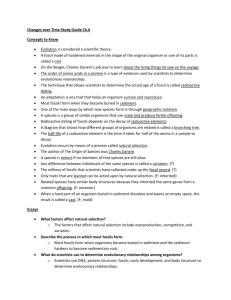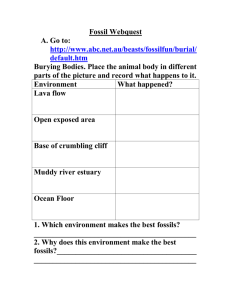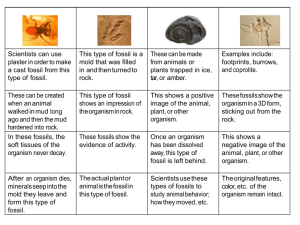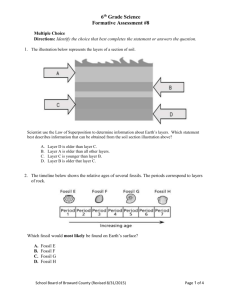ELD Lesson Plan
advertisement
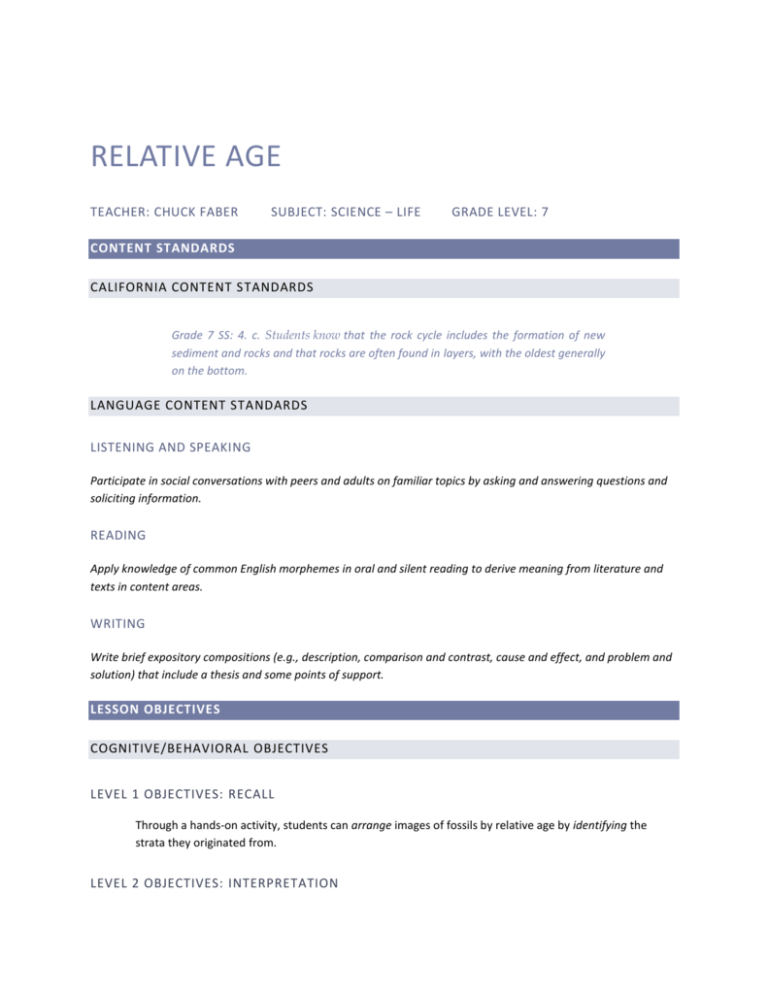
RELATIVE AGE TEACHER: CHUCK FABER SUBJECT: SCIENCE – LIFE GRADE LEVEL: 7 CONTENT STANDARDS CALIFORNIA CONTENT STANDARDS Grade 7 SS: 4. c. Students know that the rock cycle includes the formation of new sediment and rocks and that rocks are often found in layers, with the oldest generally on the bottom. LANGUAGE CONTENT STANDARDS LISTENING AND SPEAKING Participate in social conversations with peers and adults on familiar topics by asking and answering questions and soliciting information. READING Apply knowledge of common English morphemes in oral and silent reading to derive meaning from literature and texts in content areas. WRITING Write brief expository compositions (e.g., description, comparison and contrast, cause and effect, and problem and solution) that include a thesis and some points of support. LESSON OBJECTIVES COGNITIVE/BEHAVIORAL OBJECTIVES LEVEL 1 OBJECTIVES: RECALL Through a hands-on activity, students can arrange images of fossils by relative age by identifying the strata they originated from. LEVEL 2 OBJECTIVES: INTERPRETATION Through a work-sheet, students will be able to deduce the relative age of deposits of complex stratigraphic features, including folding and thrust faults. LEVEL 3 OBJECTIVES: PROBLEM-SOLVING Through a writing activity, students will determine the relative dates of various fossils, then infer the dates of fossils found in a different geographical location or in strata that have been transformed by geological processes, and support their conclusions with evidence. PSYCHOMOTOR OBJECTIVES Students will classify images of fossils (magnetic) by relative date and place them onto physical time scales observable by the teacher. Students will draw diagrams of stratigraphy based on a written prompt, and stick the fossil images in the appropriate places according to the prompt and their response. CLASSROOM DEMOGRAPHICS 25 Students Total 4 English Learners 1 Student with ADHD 2 Gifted Students LESSON MODIFICATIONS Throughout the year, students are paired up into dyads, which include specially planned lab partners. For English Learners, this will include a student who is one or two levels above their own in regards to reading and language. By the principle of Vygotsky’s Zone of Proximity, this will help English learners and other students grow cognitively. In addition, this lesson makes use of manipulatives and has an inquiry based framework, which is intuitive or visceral for most students, and encourages them to practice their language in the whole-class and small group instructions. Students are always given time to write or think before answering an important question, such as the day’s prewrite or the elaboration unit of the lesson before they share their answer with the class. This will allow all learners to formulate what they’re going to say, how it is important to the topic at hand, and how they will execute their statements to optimize for the best answers they can produce. English Learners in my class will always receive readings both personally, or through e-mail, with all difficult or important terms underlined and listed a few days to a week ahead of time. They are responsible for the same reading tasks as the other students, and I expect them to perform on the same level they do, by the time class or assessments come around. However, as they have difficulty performing at the same pace as other students, this expedited delivery of materials should help them to stay in step with the rest of the class or possibly exceed the rest of the class. When it comes to fairly difficult texts, I may highlight the part of the text that I will have them personally read in class ahead of time to allow for maximum practice. Gifted students will receive additional reading materials if they are interested in the subject, for instance, I might give them the entire Record of Time article to read on their own after class. MATERIALS Class Notebooks Writing Utensils Computer Projector Whiteboard Whiteboard Markers Large Laminated Cards with a fossil assemblage on the front and one of the letters from the word ORGANISM on the back INSTRUCTION ANTICIPATORY SET Students will have previously learned about gradualism in previous lessons, and that slow processes shape the earth over long periods of time. They also have learned that major extinction events occurred in the past due to catastrophic events. They know that extinct species populations may be represented by fossils, and they understand the process for the formation of fossils. Most students are generally interested in puzzles, and many students are interested in basic methods for determining the relative age of fossils and rock layers. I will introduce the concept of the law of superposition, and provide activities that frame the objective in a series of puzzles. This lesson will prepare students for the concepts of radiocarbon dating, and understanding that fossil evidence supports the theory of evolution. TIME ALLOTMENT Daily Pre-Write (10 min) Reading Record of Time (10 min) Stratigraphy Activity (15 min) Discussion and Recording (10 min) Short Lecture (15 min) Board Activity (15 min) Whole class discussion (15 min) TOTAL – 90 Minutes ENGAGE Students will enter the class room and answer the pre-write question on the board in their class notebooks. “Review the conditions required for a fossil to form. How are fossils dated?” Students will share their answers with the class in a short discussion. Students will begin reading the first two paragraphs of the “Overview of Dating” from the Record of Time article by Dennis O’Neil out loud in class while being called on. The words “paleoanthropologist”, “relative”, and “chronometric” will be front-loaded before the article is read. English Learners will have received the reading ahead of time including important or difficult key words which they should practice before coming to class. EXPLORE Students will begin a short activity which will help them understand the concept of the Law of Superposition. Superposition Activity Materials: 1. 2. 3. 4. 5. Clear glass or small clear acrylic box Various small colored beads or colored sand (separated by color) Class Notebooks Group students into 7 small groups of 3 or 4 (try to keep lab partners together because of planned dyads – see Lesson Modifications) Assign each group to a station. (Each station includes 3 or 4 acrylic boxes and a variety of the colored substrate, as well as the method for their dispensing) Each group will add a layer of color by dispensing the substrate one over the other on the top of the previous layer, using a different color each time, and carefully recording each color in their lab notebook in the order of which it was dispensed. Students will then observe the cut-out view of their constructed stratigraphy. Students will note which layers are newest and which ones are oldest by comparing them to the order in which they were deposited, recorded in their notebooks. EXPLAIN Students will take their seats and I will call on a few students to explain to the class what they just explored. They will now understand the principles of the Law of Superposition in which later rock layers remain near the top, while earlier layers are deposited at the bottom. I will provide a short lecture* detailing the Law of Superposition posited by Nicholas Steno and ask students “What does this apply for things embedded inside the strata?” *Lectures will NEVER exceed 20 minutes in my class and will always include images and interactive videos which will engage the student’s interests. ELABORATE Each of the groups will receive one of the ORGANISM cards, and I will tell them that the M card is the oldest, but will not give them the significance of the rest of the letters, nor allow them to share their letter with any other group. They will also receive cut out paper versions of the rest of the cards without the letters on them to work in small groups to attempt to arrange. Students will try to find out the correct position of their card in the sequence. I will place the M card on the board and have them attempt to infer the next card by comparing the fossil assemblage on the M card with their own fossil assemblages and seeing if they have at least one fossil species in common. I will remind them that extinction is permanent, and that fossils that disappeared earlier on cannot reappear in the sequence again. Groups will come up one at a time to place their card where they think it goes on the board. Discussions and respectful arguments will be allowed. By the end of the activity, the cards should spell: “ORGANISM”. We will then discuss which fossils are the oldest in the sequence, and which ones are the newest and ask them why. Students should make reference to the Law of Superposition. EVALUATE Students will reread the objectives for the day and confirm whether or not they have met them. I will be evaluating the students throughout by monitoring discussions and activities. The homework for the day will include assessments to see if they have understood the correct concepts. ASSESSMENT Formative Assessments Exploration Discussion: This is a small group and whole-class discussion exploring the activity I had them do with the sands or beads and deposits. They should be able to infer that earlier deposits are deeper and lower on the sequence, and later deposits are higher on the sequence. If they don’t grasp this information, I will cover it in the short lecture. Reading Discussion: During the reading, I will cold call students to read every one or two sentences to give them all practice in reading and academic language. Students who aren’t called on to read will still be reading along silently to not lose their place in anticipation of being called. Interspersed through the reading, I will ask level one questions, and have students respond to them to assess whether or not they are gleaning the important information from the reading. If they do not understand the reading, I will clarify it for them, or ask another student to attempt to clarify a misunderstanding. Elaboration Discussion: Students will discuss as a class how they sequenced the fossils by strata and relative age. If students were unable to complete this activity, I will guide them or introduce Activity A of the Who’s on First lab which further Summative Assessments Prewrite: I will cold-call students and have them give me the answers they were writing in their class notebooks. This will help jog their memory about fossil formation, and assess their recall of it, as well as engage the students in thinking about dating, and introduce them to the topic for today’s lesson. If they cannot recall fossil formation, I will have to rehash it. Homework: The homework will rehash the day’s lesson, and will help me assess whether or not students grasped the concepts when I collect them for grading the next day. It will further build on previous concepts they have learned throughout the year. Entry-ticket: Before entry into class, students have to answer a random level one question that has a simple answer and is something they covered previously. This will help to aid in recall and ingrain the ideas in their minds for later. If they clarifies ‘sequencing’ answer incorrectly, they will be given the correct answer and return to the end of the line to provide the right answer when their turn comes again. REFERENCES Record of Time – Dennis O’Neil (teachersdomain.org) [first 2 paragraphs of “Overview of Dating”] Who’s on First – Marsha Barber and Diane Bartos [only activity B] REFLECTION Insert Lesson Notes and Alternatives Here During Lesson ELD DEVELOPMENT PROFICIENCY (INTERMEDIATE: LEVEL 3) LISTENING AND SPEAKING: COMPREHENSION Can use simple sentences, to ask and answer questions about supporting elements, and listens to identify important concepts. LISTENING AND SPEAKING: ORGANIZATION AND DELIVERY Uses Standard English grammar and participates in social conversations with peers by asking and answering questions. Student makes some grammatical errors. READING: PHONEMIC AWARENESS, DECODING AND WORD RECOGNITION, CONCEPTS ABOUT PRINT Can produce English phonemes and recognize sound/symbol relationships in written text. Student uses this knowledge to derive meaning from text. READING: VOCABULARY AND CONCEPT DEVELOPMENT Uses more complex vocabulary and recognizes simple synonyms and antonyms. Student can read narrative with correct pacing and expression. Student can understand figures of speech and words with multiple meanings. READING: COMPREHENSION AND ANALYSIS OF GRADE-LEVEL-APPROPRIATE TEXT Can follow simple directions, identify main ideas in text, identify text features, and respond to comprehension questions with detailed sentences. READING: STRUCTURAL FEATURES OF INFORMATIONAL MATERIALS Can identify text structures and sequences of events. WRITING: PENMANSHIP Can write legibly, in simple sentences. WRITING: ORGANIZATION AND FOCUS Can follow models given by teachers to write short cohesive paragraphs that develop a central idea, but may include inconsistent use of correct grammar. WRITING CONVENTIONS: CAPITALIZATION, PUNCTUATION, AND SPELLING Can produce independent writing that includes partial consistency in use of capitalization, punctuation and correct spelling.




